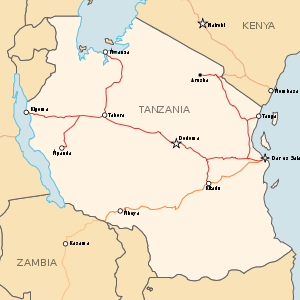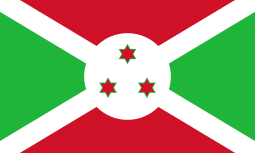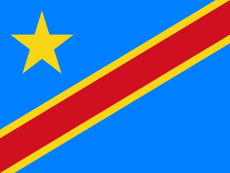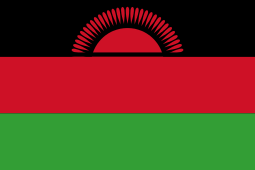Rail transport in Tanzania

1,000 mm (3 ft 3 3⁄8 in) gauge, 1,067 mm (3 ft 6 in) gauge

Dar es Salaam railway station in 1973.
Rail transport in Tanzania is conducted by two companies (Tanzania Railways Corporation and TAZARA). On 31 March, 2015 the Tanzanian government announced it would use $14.2 billion of commercial loans to build new rail infrastructure across the country before 2021 and make the country a regional transport hub.[1]
Railway links with adjacent countries
-
 Burundi - no - proposed 1,435 mm (4 ft 8 1⁄2 in)
Burundi - no - proposed 1,435 mm (4 ft 8 1⁄2 in) -
 DR Congo - decades ago there was a train ferry between Kigoma and Kalemie, in 2007 there are no ferry links and the DR Congo line to Kalemie is defunct because of a collapsed bridge. Break of gauge: 1,000 mm (3 ft 3 3⁄8 in)/1,067 mm (3 ft 6 in)
DR Congo - decades ago there was a train ferry between Kigoma and Kalemie, in 2007 there are no ferry links and the DR Congo line to Kalemie is defunct because of a collapsed bridge. Break of gauge: 1,000 mm (3 ft 3 3⁄8 in)/1,067 mm (3 ft 6 in) -
 Kenya - yes - 1,000 mm (3 ft 3 3⁄8 in) same gauge, but the link between Moshi and Voi has not operated for many years.
Kenya - yes - 1,000 mm (3 ft 3 3⁄8 in) same gauge, but the link between Moshi and Voi has not operated for many years. -
 Malawi - no - break of gauge 1,000 mm (3 ft 3 3⁄8 in)/1,067 mm (3 ft 6 in)
Malawi - no - break of gauge 1,000 mm (3 ft 3 3⁄8 in)/1,067 mm (3 ft 6 in) -
 Mozambique - no - break of gauge 1,000 mm (3 ft 3 3⁄8 in)/1,067 mm (3 ft 6 in)
Mozambique - no - break of gauge 1,000 mm (3 ft 3 3⁄8 in)/1,067 mm (3 ft 6 in) -
 Rwanda - no - proposed 1,435 mm (4 ft 8 1⁄2 in) [2]
Rwanda - no - proposed 1,435 mm (4 ft 8 1⁄2 in) [2] -
 Uganda - yes - same gauge - via train ferry from Mwanza to Port Bell or Jinja.
Uganda - yes - same gauge - via train ferry from Mwanza to Port Bell or Jinja. -
 Zambia - yes - 1,067 mm (3 ft 6 in)
Zambia - yes - 1,067 mm (3 ft 6 in)
The central line between Kigoma and Dar es Salaam carries international freight and passengers in transit from Burundi, DR Congo and Rwanda to the Indian Ocean, and the branch from Tabora to Mwanza carries freight and passengers between Uganda and the Indian Ocean.
Maps
See also
- East African Railway Master Plan
- History of rail transport in Tanzania
- Tanzania
- Transport in Tanzania
References
Notes
- ↑ African Markets - Factors to watch on March 31, Reuters, http://www.reuters.com/article/2015/03/31/africa-factors-idUSL6N0WX0EG20150331
- ↑ Railways Africa - STANDARD GAUGE FOR RWANDA
Further reading
- Robinson, Neil (2009). World Rail Atlas and Historical Summary. Volume 7: North, East and Central Africa. Barnsley, UK: World Rail Atlas Ltd. ISBN 978-954-92184-3-5.
External links
![]() Media related to Rail transport in Tanzania at Wikimedia Commons
Media related to Rail transport in Tanzania at Wikimedia Commons
This article is issued from Wikipedia - version of the 4/1/2015. The text is available under the Creative Commons Attribution/Share Alike but additional terms may apply for the media files.